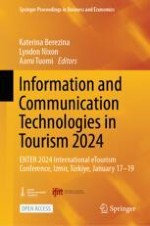
Open Access 2024 | OriginalPaper | Buchkapitel
Get Ready for the Future of Tourism and Hospitality with the Smart Hospitality Wheel
verfasst von : Nicolette Yvonne Bolté, Ruth Pijls, Sanne Ten Tije
Erschienen in: Information and Communication Technologies in Tourism 2024
Verlag: Springer Nature Switzerland
Aktivieren Sie unsere intelligente Suche, um passende Fachinhalte oder Patente zu finden.
Wählen Sie Textabschnitte aus um mit Künstlicher Intelligenz passenden Patente zu finden. powered by
Markieren Sie Textabschnitte, um KI-gestützt weitere passende Inhalte zu finden. powered by